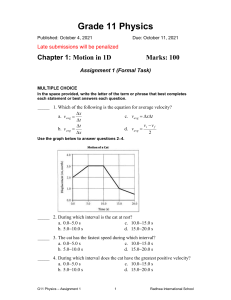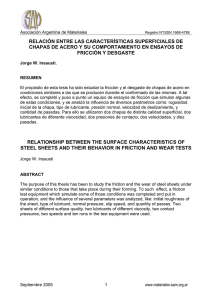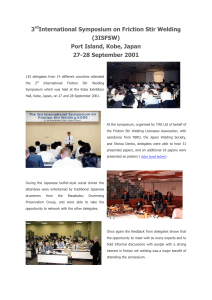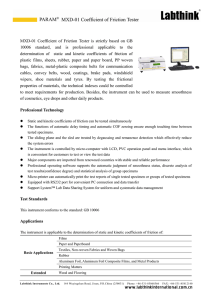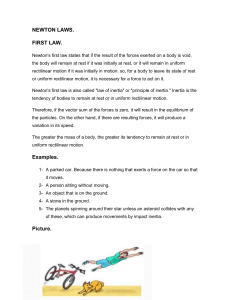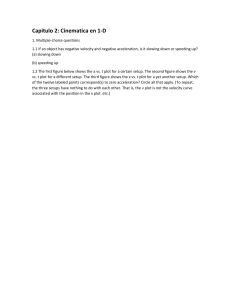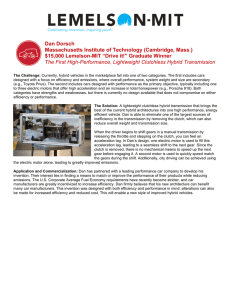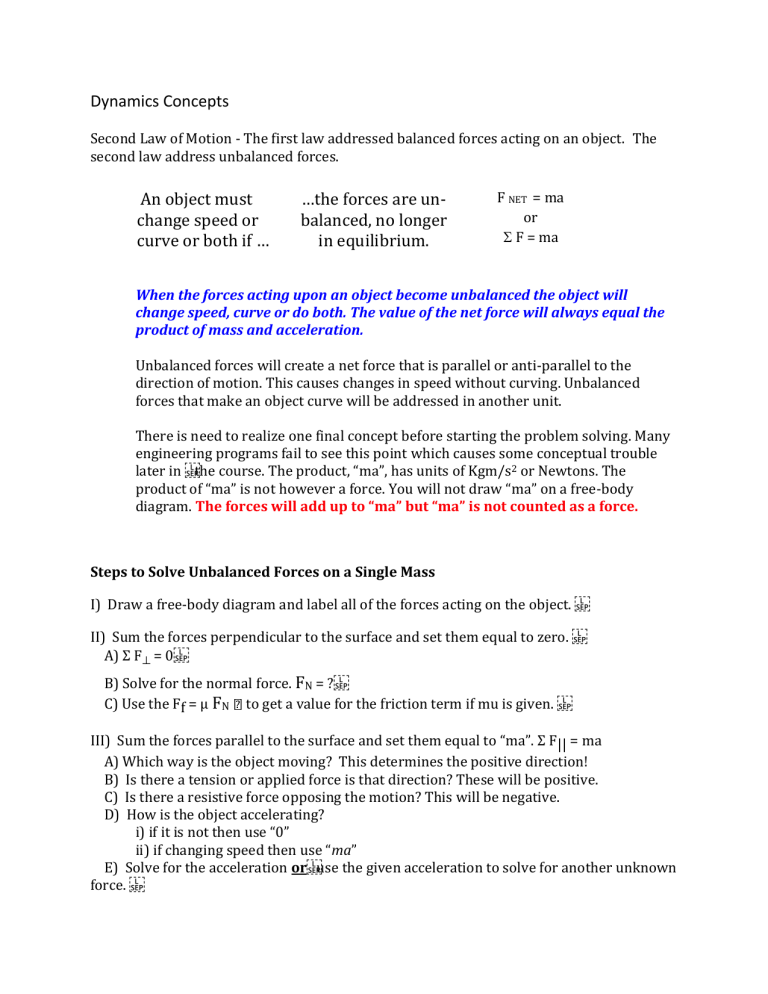
Dynamics Concepts Second Law of Motion - The first law addressed balanced forces acting on an object. The second law address unbalanced forces. An object must change speed or curve or both if … …the forces are unbalanced, no longer in equilibrium. F NET = ma or F = ma When the forces acting upon an object become unbalanced the object will change speed, curve or do both. The value of the net force will always equal the product of mass and acceleration. Unbalanced forces will create a net force that is parallel or anti-parallel to the direction of motion. This causes changes in speed without curving. Unbalanced forces that make an object curve will be addressed in another unit. There is need to realize one final concept before starting the problem solving. Many engineering programs fail to see this point which causes some conceptual trouble later in the course. The product, “ma”, has units of Kgm/s2 or Newtons. The product of “ma” is not however a force. You will not draw “ma” on a free-body diagram. The forces will add up to “ma” but “ma” is not counted as a force. Steps to Solve Unbalanced Forces on a Single Mass I) Draw a free-body diagram and label all of the forces acting on the object. II) Sum the forces perpendicular to the surface and set them equal to zero. A) Σ F⊥ = 0 B) Solve for the normal force. FN = ? C) Use the Ff = μ FN to get a value for the friction term if mu is given. III) Sum the forces parallel to the surface and set them equal to “ma”. Σ F|| = ma A) Which way is the object moving? This determines the positive direction! B) Is there a tension or applied force is that direction? These will be positive. C) Is there a resistive force opposing the motion? This will be negative. D) How is the object accelerating? i) if it is not then use “0” ii) if changing speed then use “ma” E) Solve for the acceleration or use the given acceleration to solve for another unknown force. IV) Use the acceleration from step III as one of the three out of five givens in the kinematics equations. Note: sometimes you use three given kinematics values to solve for acceleration before you do step III. Depending upon the problem, steps III and IV may be reversed in order. Kinematic Equations x = v0t + 1/2at2 v = v0 +at v2 = v02 +2ax x = (v + v0) t 2 Dynamics Example Problems Example 1: Horizontal Problem with friction Fapp A block rests on a level surface with friction. A force is applied horizontally. Givens: a) FN – W = 0 FN – 60 = 0 FN = 60 N m = 6 kg; Fapp = 54 N; mu = 0.40; v0 = 0m/s; t = 5 sec b) f = (FN) f =(60) f = 24 N c) Fapp – f = ma 54 – 24 = 6a a = 5 m/s2 d) v = v0 +at v = 0 + 5 (5) v = 25 m/s Example 2: Problem with Fapp at an upward angle. PULLING an object on a level surface: (Fapp = 100N, m = 12kg, = 30o and µ= 0.4) a) FN – W + Fapp sin = 0 FN – 120 +100 sin 30°= 0 FN = 70 N b) f = (FN) f =(70) f = 28 N c) Fapp cos – f = ma 100cos 30 – 28 = 12a a = 4.88 m/s2 Example 3: Problem with Fapp at a downward angle. PUSHING an object on a level surface: (Fp = 100N, m = 12kg, = 30o and µ= 0.4) a) FN – W - Fapp sin = 0 FN – 120 -100 sin 30°= 0 FN = 170 N b) f = (FN) f =(170) f = 68 N c) Fapp cos – f = ma 100cos 30 – 68 = 12a a = 1.55 m/s2 Example 4 : A FRICTIONLESS Inclined plane Given: m = 12 kg; =60°, surface is frictionless. a) FN – W cos = 0 FN – 120 cos 60°= 0 FN = 60 N b) W sin = ma m g sin = m a a = 10 cos 60° a = 8.66 m/s2 Example 6 : Fapp & FRICTION on an Inclined plane f Fapp Given : Fg m = 12 kg; =60°; Fapp = 40 N; = 0.2 a) FN – W sin = 0 FN – 120 sin 30°= 0 FN = 60 N b) Wcos–f –Fapp =ma mg cos –f –Fapp =ma (12)(10) - (0.2)(60)-40 = 12 a = 4.32 m/s2 Dynamics Intro The sum of the forces in the x-direction now = ma. Use the sum of the forces in the y direction = 0 to find the normal force. Then solve for the rest of the unknowns. Single Masses 1. A 5 Kg object rests on a level surface with a force of 42 N is applied horizontally for 6 seconds. If the friction force is 6N, what is the object’s A) normal force B) acceleration C) coefficient of friction and D) final speed ? 2. A 4 Kg object rests on a level surface with a kinetic coefficient of friction of 0.40. A force of 37.7 N is applied horizontally for 6 seconds. What is the object’s A) normal force B) acceleration and C) final speed. 3. A 6.4 kg object sits on a level surface with a coefficient of friction of 0.60. After a force is applied, the object accelerates at 5 m/s2. What is the object’s A) normal force B) friction force and C) force applied. 4. A 44.9 Kg object is resting on a level surface. A force of 500 N at 26 degrees above the horizontal is applied to the block over a distance of 49 m. The kinetic coefficient of friction between object and surface is .408. What is the object’s A) acceleration and B) final speed? 5. A 139.6 kg object is resting on a level surface. A force of 800N 28 degrees above the horizontal is applied for 4 seconds. The object moves 24 m during this time. A) What is the acceleration of the object? B) What is the force of friction? C) What is the kinetic coefficient of friction? 6. A 96.5 Kg crate is resting on a level floor. A 900 N force at 48 degrees below the horizon is applied over a distance of 18.9 m. The kinetic coefficient of friction is 0.122. A) What is the object’s acceleration? B) How long was the force applied? C) What is the final speed of the object? D) if the applied force is then removed how much farther will the block slide? (hint: need to find a new normal force & friction force) 7. A 22.6 Kg box rests on a level surface. A force of 300 N at 36.9 degrees below the horizontal is applied for 2.2 seconds which produces a final speed of 15.4 m/s. What is the A) object’s acceleration, B) displacement and C) kinetic coefficient of friction? 8. A 1kg object is placed at the top of an incline plane which has been raised to 53.1 degrees above the horizontal. The base length of the incline is 6m. The coeff. of friction between the object and the plate is 0.652. A) What is the acceleration of the object? B) How long will it take to reach the bottom? C) What will be its speed at the bottom? 6m 9. Repeat 8 for a frictionless surface. 10. *** Find the angle so that a box on an incline plane with a coefficient of friction of 0.652 would slide down at a constant velocity. Answers 1. a) 50 N 2. a) 40 N 3 a) 64 N 4. a) 7.92 m/s2 5. a) 3 m/s2 6.a) 4.2 m/s2 7 a) 7 m/s2 8 a) 4.08 m/s2 9 a) 8 m/s2 10 ****33.1° b) 7.2 m/s2 b) 5.43 m/s2 b) 38.4 N b) 27 m/s b) 288 N b) 3 sec b) 16.9 m b) 2.21 sec b) 1.6 sec c) 0.12 c) 32.6 m/s c) 70.4 N c) c) c) c) c) d) 43.2 m/s 0.306 12.6 m/s d) 65 m 0.201 9.0 m/s 12.6 m/s Vertical Dynamics Summing forces for an accelerating elevator: Fig A : FN – W = 0 Fig B : FN – W = ma Fig C : W - FN = ma Fig D : W - FN = mg Summary: 1. The scale reading is the normal force. 2. The normal force is > than the weight of the passenger if a is upward. 3. The normal force is < than the weight if a is downward 4. The normal force will = the weight of the passenger for a stationary or constant velocity elevator, because the a is zero. 5. If the elevator string breaks, the system is in free-fall and the acceleration is equal to –g. The normal force will be zero. Initial velocity (up or down) Direction of a (up or down) FN vs W Accelerating upward Decelerating upward Accelerating downward Decelerating downward If velocity and acceleration are in the same direction, elevator gets faster. If velocity and acceleration are in the OPPOSITE direction, elevator gets slower. When we talk about the ropes, instead of the normal force on a scale, we use tension in the equations. Fig A: T – W = ma Fig B: W – T = ma The Atwood Machine If mass2 is heavy than mass1, then m1 will accelerate up and m2 will accelerate down. mass1 : T – W1 = m1a mass2 : W2 – T = m2a __________________ (add) m2g – m1g = m1a + m2a a = (m2 – m1)g (m2 + m1) m1 m2 6 kg The Table with a mu of 0.5 and a Pulley mass1 : T – f = m1a 4 kg 2.2m Dynamics by Wayne and Me - Multiple Masses with Strings mass2 : W2 – T = m2a __________________ (add) m2g – f = m1a + m2a a = (m2g – f) (m2 + m1) 1. An Atwood’s Machine is made using a 9 kg (m1) block and a 3 kg (m2) block. The system starts from rest with the 9 kg block 2.45 m above the ground. A) What is the acceleration of the blocks? B) What is the tension in the lines? 2. A 9 kg block is placed on a frictionless level table. A pulley is mounted on the edge of the table. A 3 kg block is suspended in the air by means of a string which passes over the pulley to the 9 kg block. A) what is the acceleration of the blocks? B) What is the tension in the lines? C) What would be the acceleration and tension in the lines if the blocks were switched? 3 Repeat 2 a, b, and c if there is a coefficient of friction between table and block of .129. 4 A frictionless, inclined plane is raised to 30 degrees above the horizontal and a pulley is mounted at the top. A 6 kg (m1) block is placed on the incline. A 5 kg (m2) block is suspended in air beneath the pulley by means of a string which passes over the pulley to the 6 kg block. A) Which way will the 5 kg block move? B) What is the acceleration of the blocks? C) What is the tension in the line? D) What would be the acceleration if the masses were exchanged for each other? E) What is the new tension? 5 A 6 m long board has one end raised until it makes an angle of 60 degrees with the horizontal. A pulley is mounted at the top of the incline. A 20 kg block is placed at the top of the inline next to the pulley. The value of mu sub k is .467. A 5 kg block is suspended in air below the pulley by means of a string which is connected to the 20 kg block. A) what is the acceleration of the blocks? B) What is the tension in the line? C) How long will it take the 5 kg block to strike the pulley if it was initially at rest on the ground? 6 Reverse the masses for #20 and start the 5 kg block at the bottom of the incline and the 20 kg block next to the pulley. Answer question a and b only. 7 Three blocks (M1 = 10 kg, M2 = 20 kg, M3 = 30 kg) are placed on a level frictionless surface as shown below. A horizontal force of 180 N is applied to the 30kg block. A) What is the acceleration of the blocks? B) What is the tension in #1? C) What is the tension in line #2? #1 #2 Fapp M1 M2 M3 8 Repeat #7 if the kinetic coefficient of friction between all blocks and the surface is 0.204. 9 An Atwood’s machine is made using three blocks. M1 is 8 kg and starts on the ground. A string runs from the 8 kg block up over the pulley and back down to M2 which is 2 kg. A second string runs from below the 2 kg block to the top of a 10 kg block labeled M3 in the diagram to the right. M3 starts 1 m above the ground. A) What is the acceleration of the blocks? B) what is the tension in line #2 which is between M3 and M2? C) what is the tension in the line between M1 and M2? 10. A 7 kg block is placed on a frictionless surface. A 3 kg block is placed on the surface next to the 7 kg block. A force of 50 N is applied horizontally to the 7 kg block. A) What is the acceleration of the blocks? B) What is the force of 7 kg block pushing on the 3 kg block? C) Repeat part b if the force acts from left to right on the 3 kg block instead. 1. a) 5.0 m/s2 2. a) 2.5 m/s2 3. a) 1.5 m/s2 b) 45 N b) 22.5 N b) 25.5 N 4. a)Down 5. a) 3m/s2 6. a) 5.8 m/s2 b) 1.82 m/s2 c) 40.9N b) 65 N c) 1.86s b) 84N 7. a) 3 m/s2 8. a) .96m/s2 9. a) 2.0 m/s2 10. a) 5m/s2 b) 30N b) 30N b) 80 N b) 15N c) 7.5 m/s2; 22.5 N c) 7.2 m/s2; 25.2 N c) 90N c) 90N c) 96 N c) 35N Newton’s 3rd Law and Stacked Boxes d) 3.18 m/s2; 34 N Fapp 70 kg 30 kg 50 kg Example #1: Objects stacked horizontally and moved horizontally. A 600 N applied force moves the three carts shown in the figure above. Find the acceleration of all three carts. How much force does the 70 Kg cart exert on the 30 Kg cart? How much force does the 30 Kg cart exert on the 50 Kg cart? The following three equations can F|| 70 : 600 – F73 = 70a F||30: F73 - F35 = 30a F||50: F35 – 0 = 50a be generated: Summing these equations gives: 600 –0 =150 a 2 a = 4m/s 2 By substitution of “a = 4 m/s ” back into the other equations you find that the 30 kg cart must push on the 50 kg cart with a force of 200 N. Also, the 70 kg cart pushes on the 30 kg cart with a force of 320 N. There is one other fact that is more than just coincidence. The force, F73, is moving 8/15 of the total mass and the value for F73 is 8/15 of the applied force. The force, F35, is moving 5/15 of the total mass and has a value that is 5/15 of the applied force. This is due to Newton’s Second Law of Motion. Example #3 Slipping and Not slipping Step 1. Find the MAX fs. M1 = 8 kg s = 0.5 k = 0.25 fs = s FN8 fs = You may think MAX Fapp before slipping is 40 N, but it is bigger! M2 = 12 kg Step 2. Find the MAX Fapp before slipping. 12 kg block fs = m12 a 40 = 12 a a = 3.33 m/s2 8 kg block Fapp - fs = m8 a Fapp – 40 = 8(3.33) Fapp = 67.7 N Step 3. Find the acceleration of the boxes if Fapp is BIGGER than MAX Fapp. In this step, I decided to set Fapp = 90 N fk = k FN8 12 kg block fk = m12 a 8 kg block because it is slipping. fk = 20 = 12 a a = 1.67 m/s2 Fapp - fs = m8 a 90 – 20 = 8a a = 8.75 m/s2 Step 4. Find the acceleration of the blocks if Fapp is SMALLER than MAX Fapp. In this step, I decided to set Fapp = 50 N 12 kg block fk = m12 a 8 kg block fs is not known f = 12 a Fapp - fs = m8 a 50 – f = 8 a add eq: 50 = 20 a a = 2.5 m/s2 f = 30 N And for #6: do the example problem #3, but with Fapp on the bottom block. Book Problems 5.12 a) 3.76 m/s2 b) 21.3 N 14. a) 2.08 m/s2 b) 62.5 N 16. a) 12° c) 104.1 N b) v = 1.58 m/s2 20. a) 1.81 m/s2 b) 2.18 m/s2 33. a) x = 51.5 m b) v0= 16.0 m/s 34. mu = 0.556 a = -2.18 m/s2 c) -10 m/s2 80. a = 4.24 m/s2 85. a) 88 N b) 80 N 91. T1 = 48N; T2 = 102 N; m = 12.75 kg 92. a) left b) 0.667 m/s2 b) 433 N Dynamics by H & R (and one more practice problem) d) 7412 N, 0N 61. a) 27 N b) 3 m/s2 34. a) 58.8 N, 6.08 m/s2 b) -0.98 m/s2 54. 23 kg 55. a) 1.1 N b) 0.9 c) accelerations are the same, but different masses, so different F. 56. a) 2.5 m/s2 b) 30 N One more practice problem k = 0.25 s = 0.5 a) Find the maximum static friction. b) Find the acceleration(s) of the blocks if the applied force is 90 N. c) Find the acceleration(s) of the blocks if the applied force is 50 N. AP Dynamics FR Problem #1 A small block of mass M B = 0.50 kg is placed on a long slab of mass M S = 3.0 kg as shown above. Initially, the slab is at rest and the block has a speed v0 of 4.0 m/s to the right. The coefficient of kinetic friction between the block and the slab is 0.20, and there is no friction between the slab and the horizontal surface on which it moves. (a) On the dots below that represent the block and the slab, draw and label vectors to represent the forces acting on each as the block slides on the slab. At some moment later, before the block reaches the right end of the slab, both the block and the slab attain identical speeds vf . (b) Calculate vf . (c) Calculate the distance the slab has traveled at the moment it reaches v f . Problem #2 Problem # 3 Problem # 4 Problem #5 Problem #6 Problem #7 Practice Dynamics Test Problem A. An empty sled of mass 25 kg slides down a muddy hill with a constant speed of 2.4 m/s. The slope of the hill is inclined at an angle of 15° with the horizontal as shown in the figure above. 1. Calculate the time it takes the sled to go 21 m down the slope. 2. On the dot below that represents the sled, draw/label a free-body diagram for the sled as it slides down the slope. 3. Calculate the frictional force on the sled as it slides down the slope. 4. Calculate the coefficient of friction between the sled and the muddy surface of the slope. Problem B A pulley is placed at the corner of a flat surface. A 4 kg box is placed on the surface. An 8 kg object is suspended under the pulley and connected to the box by string. The coefficient of friction between box and surface is μ = 0.8. 1. The friction acting on the 4 Kg block is ___N. A)10 B)20 C)32 D)40 2 2. The objects will accelerate at ___m/s . A)3 B)4 C)5 D)6 3. The tension while accelerating is ___N. A)24 B)32 C)48 D)80 4. If the surface between the 4kg block and the surface is now frictionless, the 2 blocks will accelerate at ___ m/s . A) 2.0 B) 3.2 C) 5.0 D) 6.7 5. If the surface is frictionless, the tension in the line is ___N. A) 14 B) 27 C) 42 D) 52 Problem C A net force of 24 N acts on a 60 N object. The net force is applied for 5 seconds starting the object from rest. 6. The object accelerates at ____ m/s . A)3 B)4 C)5 D)6 E)7 7. The distance traveled during the 5 second interval is ___m. A)37.5 B)50 C)62.5 8. The object has a final speed of ___m/s. A)20 B)25 C)30 D)75 D)35 Problem D A 60 Kg crate is placed at rest on a level floor. An applied force of 390 N at 22.6° above the horizontal moves the crate from rest over a distance of 16.3 m. The coefficient of friction between crate and floor is μ = 0.6. 9. The normal force acting on the block is ___N. A) 150 B) 300 C) 450 D) 600 10. The force of friction acting against the block is ___N. A) 180 B) 270 C) 360 D) 420 11. The object accelerates at ___ m/s . A) 1.5 B) 2.0 C) 2.5 D) 3.0 12. The final speed of the crate at the end of the 16.3 m distance is ___ m/s. A)7 B)8 C)9 D)10 13. If the applied force is removed, the crate will begin to slide to a stop at a rate of - ___ m/s . A)3 B)4 C)6 D)8 Problem E A 20 Kg crate is placed at rest on a level floor. An applied force of 340 N at 28.1° below the horizontal moves the crate from rest over a distance of 5.3 m. The coefficient of friction between crate and floor is μ = 0.5. 14. The normal force acting on the block is ___N. A)200 B)250 C)360 D)420 15. The force of friction acting against the block is ___N. A) 180 B) 270 C) 360 D) 420 16. The object accelerates at ___ m/s . A) 3 B) 4 C) 5 D) 6 17. The final speed of the crate at the end of the 5.3 m distance is ___ m/s. A) 7 B) 8 C) 9 D) 10 18. If the applied force is removed the crate will begin to slide to rest at a rate of-___m/s2 . A) 3 B) 4 C) 5 D) 6 MC 19. A simple Atwood's machine is shown in the diagram. It is composed of a frictionless lightweight pulley with two cubes connected by a light string. If cube A has a mass of 4.0 kg and cube B has a mass of 6.0 kg, the system will move such that cube B accelerates downwards. What would be the tension in the two parts of the string between the pulley and the cubes? (A) TA =48N; TB =71N (B) TA =48N; TB =48N (C) TA =48N; TB =42N (D) TA =39N; TB =59N (E) TA =39N; TB =39N 20. A person pushes a block of mass M=6.0kg with a constant speed of 5.0 m/s straight up a flat surface inclined 30.0° above the horizontal. The coefficient of kinetic friction between the block and the surface is 0.40. What is the net force acting on the block? (A)0N (B)21N (C)30N (D)51N (E)76N 21. An object on an inclined plane has a gravitational force of magnitude 10 N acting on it. Which of the following gives the correct components of this gravitational force for the coordinate axes shown in the figure? The y-axis is perpendicular to the incline’s surface while the x-axis is parallel to the inclined surface. x-component y-component (A) + 6 N -8N (B) + 8 N -6N (C) - 6 N +8N (D) - 8 N +6N (E) 0N + 10 N Practice Test Answers Problem A a) t = 8.75 s b) c) f = 64.7 N d) mu = 0.268 Problem B 1. C 2. B 3. C 4. D 5. B Problem C 6. B 7. A 8. A Problem D 9. C 10. B 11. A 12. A 13. 13 Problem E 14. C 15. A 16. D 17. B 18. C MC 19. B 20. A 21. A
